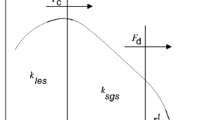Abstract
The article deals with the numerical simulation of transitional flows. The aim is to evaluate two models for turbomachinery flows. The first model is a simple algebraic model developed by Straka and Příhoda and the second one is the three-equation \(k-k_L-\omega \) model of Walters and Cokljat. Both models were tested for shear flows over the flat plate (ERCOFTAC T3A, T3B, and T3A\(-\) cases) for natural and bypass transition, over two airfoils in a tandem for the transition due to incoming wake and finally for the flow through a subsonic turbine blade cascade. Both models are compared to available experimental data.









Similar content being viewed by others
Notes
Octave is a high-level language for numerical computations similar to Matlab.
References
Canepa E, Cattanei A, Pittaluga F, Ubaldi M, Zunino P (2003) Transitional boundary layer on the suction side of a turbine blade at different Reynolds numbers. In: 5th European conference on turbomachinery, Praha, pp 911–923
Cho JR, Chung MK (1992) A \(k-\epsilon -\gamma \) equation turbulence model. J Fluid Mech 237:301–322
Coirier WJ (1994) An adaptively-refined, Cartesian, cell-based scheme for the Euler and Navier–Stokes equations. Ph.D. thesis, University of Michigan
Coupland J (1990) Flat plate transitional boundary layers, ERCOFTAC classic database. http://cfd.mace.manchester.ac.uk/ercoftac
Di Pasquale D, Rona A, Garrett SJ (2009) A selective review of cfd transition models. AIIA Paper (2009-3812)
Durbin PA (1991) Near-wall turbulence closure modeling without ‘damping functions’. Theor Comput Fluid Dyn 3:1–13
Ferziger JH, Perić M (1999) Computational methods for fluid dynamics. Springer, Berlin
Fürst J (2008) The WLSQR scheme for the flows in complex geometry. In: Finite volumes for complex applications V. ISTE Ltd, London, pp 431–438
Fürst J (2009) The high order WLSQR scheme and its applications in turbomachinery. In: Dick E, Deconinck H (eds) Computational fluid dynamics 2006. Springer, Berlin, pp 155–160
Fürst J (2012) Numerical simulation of transitional flows with laminar kinetic energy. In: 18th International conference engineering mechanics, Svratka, pp 309–315
Kim KH, Kim C, Rho OH (2001) Methods for the accurate computations of hypersonic flows I. AUSMPW+ scheme. J Comput Phys 174:38–80
Kok JC (2000) Resolving the dependence on free stream values for the \(k-\omega \) turbulence model. AIAA J 38:1292–1295
Langtry RB, Menter FR (2005) Transition modeling for general CFD applications in aeronautics. AIAA Paper 2005-522
Lee H, Kang S (2000) Flow characteristics of transitional boundary layers on an airfoil in wakes. J Fluids Eng 122:522–532
Mayle RE, Schulz A (1997) The path to predicting bypass transition. J Turbomach 119:405–411
Medic G, Durbin PA (2002) Toward improved prediction of heat transfer on turbine blades. J Turbomach 124:187–192
Narasimha R (1957) On the distribution of intermittency in the transition region of a boundary layer. J Aerosp Sci 24:711–712
Příhoda J, Hlava T, Kozel K (1999) Modelling of bypass transition including the pseudo-laminar part of the boundary layer. Z Angew Math Mech 79(3):S699–S700
Satta F, Simoni D, Ubaldi M, Zunino P (2007) An experimental investigation of the dissipation mechanisms in the suction side boundary layer of a turbine blade. In: Proceedings of the 8th international symposium on experimental and computational aerothermodynamics of internal flows, Lyon
Straka P, Příhoda J (2010) Application of the algebraic bypass-transition model for internal and external flows. In: Proceedings of the conference on experimental fluid mechanics (EFM10), Liberec, pp 636–641
Ubaldi M, Zunino P, Campora U, Ghiglione A (1996) Detailed velocity and turbulence measurements of profile boundary layer in a large scale turbine cascade. ASME Paper 96-GT-42
Walters DK, Cokljat D (2008) Three-equation eddy-viscosity model for Reynolds-averaged Navier–Stokes simulations of transitional flow. J Fluids Eng 130:121401–121414
Walters DK, Leylek JH (2004) A new model for boundary layer transition using a single-point RANS approach. J Turbomach 126:193–202
Yoder DA, Georgiadis NJ (1999) Implementation and validation of the Chien k-\(\epsilon \) turbulence model in the WIND Navier–Stokes code. AIAA Paper 99-0745
Acknowledgments
The work was supported by the Grants No. P101/10/1329, P101/12/1271 of the Czech Science Foundation, the project TIP FR-TI3/343 of the Ministry of Industry and Trade of the Czech Republic, and by the institutional support RVO 61388998.
Author information
Authors and Affiliations
Corresponding author
Rights and permissions
About this article
Cite this article
Fürst, J., Příhoda, J. & Straka, P. Numerical simulation of transitional flows. Computing 95 (Suppl 1), 163–182 (2013). https://doi.org/10.1007/s00607-012-0266-0
Received:
Accepted:
Published:
Issue Date:
DOI: https://doi.org/10.1007/s00607-012-0266-0




